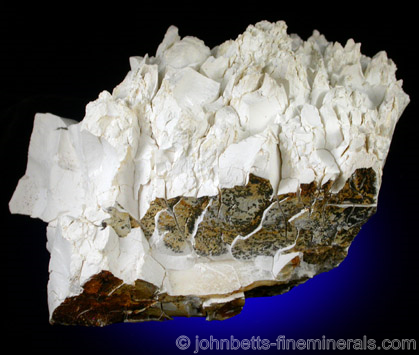The Mineral kaolinite

Kaolinite is a clay mineral, with a soft consistency and earthy texture. It is easily broken and can be molded or shaped, especially when wet. Kaolinite is a lackluster and uninteresting mineral on its own, but it occasionally forms interesting pseudomorphs, especially after feldspars. It is also a common accessory to other minerals, including gem crystals in decomposing feldspar pegmatites.
The term Kaolinite describes the name of a group of closely-related clay minerals, as well as an individual member mineral of the group. The members of the Kaolinite group all have the same (or similar) chemical formula, and they are Dickite, Kaolinite, Nacrite, Halloysite, and Odinite. Kaolinite also has a very similar chemical formula to Serpentine, and is sometimes considered a member of the Serpentine group.
Kaolinite is the most common clay mineral, and entire clay deposits can be composed of this mineral. There are many commercial Kaolinite mines where this mineral is mined in large volumes for its various industrial uses. Kaolinite is named after the Kao-ling, a mountain in Jiangxi Province in China where this mineral was well-known from early times.
Chemical Formula
Al2Si2O5(OH)4
Color
White, gray, yellow, beige. May also be darker colored brown, orange, or reddish-brown from iron oxide impurities.
Crystal System
Monoclinic
Properties
Streak
White |
Hardness
2 - 2.5 |
Transparency
Opaque. Rarely translucent. |
Specific Gravity
2.6 |
Luster
Dull |
Cleavage
1,1 |
Fracture
Earthy |
Tenacity
Brittle, sectile |
Other ID Marks
Kaolinite is very friable, and can be cut and molded, especially when wet. May also give off a clay-like odor when wet or when breathed upon.
|
Crystal Habits
Most often as unshaped compact masses. Crystals are microcrytalline as tiny grains and plates. Crystals are rarely visible to the naked eye.
Varieties
-
Variety of Kaolinite from Pianling, Xiuyan Co., China.
Uses
Kaolinite is the most abundant clay mineral, and is used for pottery and ceramics. It is also very important in the production of paper, and is used in pharmaceuticals as an ingredient in some medications such as stomach soothers. Kaolinite is also used as an ingredient in some cosmetics, soaps, paint gloss, and toothpastes.
Noteworthy Localities
Kaolite is very common and found worldwide. It is commercially mined throughout the world as a natural resource for its many uses. Despite its abundance, Kaolinite is seldom represented in collections due to lackluster aesthetics. Only noteworthy pseudomorph localities that have produced mineralogically interesting forms of this mineral will be mentioned here.
Doubly terminated carlsbad twins of Orthoclase that have been pseudomorphed by Kaolinite are well-known from the St Austell District, Cornwall, England. The Vilui River in Chernyshevsk, Siberia, Russia has produced triangular shaped pseudomophs of Kaolinite after Hydrogarnet. Well-formed Kaolinite pseudomorphs after Leucite come from Poços de Caldas, Minas Gerais, Brazil.
Common Mineral Associations
Feldspar, Quartz, Calcite, Dolomite, Barite
Distingushing Similar Minerals
The unique habits of Kaolinite make it easily distinguishable from other minerals. However, other clay minerals can be very similar and sometimes impossible to distinguish without complex identification methods such as heat absorption or x-ray analysis.